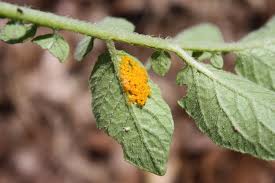This garden miner has Irish roots. In fact, my mother is full blooded, 100% Irish. My father was 50%, but in his heart, more like 98%, holding out just a bit for his hasenpfeffer and Wiener schnitzel which he enjoyed a few times a year at his favorite German restaurants. At home, though, Irish cooking was the norm. And yes, we had some potatoes.
So when I can grow potatoes, life is good in the garden. I enjoy feeling close to my roots both figuratively and literally. And closeness is what the plant needs; it wants you to pay attention.
Central Virginia is doing the Irish thing right now. We’ve had enough rain and gray skies to help the potato plants stand tall as they shout Erin go Bragh! And that clamor has called forth some very hungry and prolific potato beetles. They can wipe out your crop, so if you too are in need, let me help you identify them and show you what to do to keep your plants healthy:
 |
| REM would be so proud |
 |
Not the Mr. Stripey I want to see in the garden |
Here he is. Ugh. Cool looking, for sure, but you don't want him around. So what to do when you see this? Crush him between your fingers (wear gloves cuz the yellow ooze is just gross) or just pop him into a cup of soapy water. BTW, soapy water is my method of choice for Japanese Beetles.
Then check the underside of your leaves for the yellow eggs and crush them. Just smear them right up. I have recently discovered that as the larvae hatch, they eat their way through to the upper side of the leaf from the spot in which they were born. Nature is so fascinating when you can put your aggravation at what's happening to your plant aside for a moment.
 So you missed some eggs, and you will. Not to worry, yet. You can see in my first picture that some of my leaves have holes. That's because these guys made it through my defense. This is why you need to check your plants regularly. You're bound to hit the cycle somewhere. These are quite crushable as well, so have at it. They disperse quickly, so if you see one, keep looking over the plant and at the neighboring potato plants. Once while visiting Monticello, I was stunned to see millions of these things on the potato plants in the garden. A woman passed by and said, "Now that's a different kind of ladybug!" I said, "Those aren't ladybugs, that's negligence." On the way home I don't know who was more upset: Me about the bugs or my youngest upon learning that Thomas Jefferson owned slaves. It was a long, somber trip home.
So you missed some eggs, and you will. Not to worry, yet. You can see in my first picture that some of my leaves have holes. That's because these guys made it through my defense. This is why you need to check your plants regularly. You're bound to hit the cycle somewhere. These are quite crushable as well, so have at it. They disperse quickly, so if you see one, keep looking over the plant and at the neighboring potato plants. Once while visiting Monticello, I was stunned to see millions of these things on the potato plants in the garden. A woman passed by and said, "Now that's a different kind of ladybug!" I said, "Those aren't ladybugs, that's negligence." On the way home I don't know who was more upset: Me about the bugs or my youngest upon learning that Thomas Jefferson owned slaves. It was a long, somber trip home.  |
| BREAKING NEWS! Assassin caught snacking between meals! |
Had there been ladybugs on the plants, all would be well. They're a great benficial to eat the eggs, and my friend the assassin (he's a beetle) goes after the larvae. So that's another thing to check...who else is hanging around? If you see parasitic wasps, ladybugs, assassin beetles, and/or spiders, congratulations! You have just won the prize for providing what your garden needs to attract beneficials. They're the hired help whose remuneration is good eats that you're happy to share. Doesn't the assassin look like he got caught in the act on some convenience store camera? I may have to send this to "Inside Edition."
 |
| Buckwheat - so easy to plant, just broadcast seed EVERYWHERE. You'll be glad you did. |
Lastly, how do you attract beneficials and provide other deterrents? Plant buckwheat and clover (red or white) near your plants to attract the bugs you want. Nasturtium (which comes from the Latin meaning "to turn the nose") repels potato beetles, as do dill and cilantro, which also happen to taste really good with potatoes - a nice added benefit. Eggplant is a good trap crop, but the two I planted did such a good job there's nothing left of them, so I'm moving on to a new plan.
So pay attention, and enjoy! As you check your plants, take a peek and see if you have some new potatoes coming in. Who knows? You might just get a few nuggets to enjoy for your time and effort.

No comments:
Post a Comment